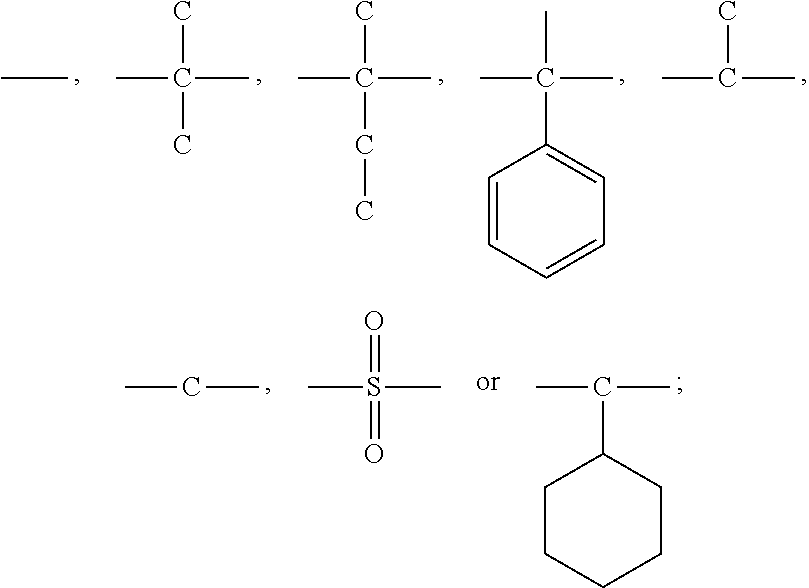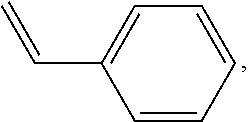Composite material made of thermosetting resin composition
a technology of thermosetting resin and composite materials, which is applied in the direction of thermoplastic polymer dielectrics, electrical apparatus, printed circuits, etc., can solve the problems of unfavorable automated continuous production of copper clad laminates, disadvantageous cure of known compositions, and high viscidity of polybutadiene, etc., to improve substrate processability, good rigidity, and easy cutting
Inactive Publication Date: 2020-05-28
NANYA PLASTICS CORP
View PDF0 Cites 2 Cited by
- Summary
- Abstract
- Description
- Claims
- Application Information
AI Technical Summary
Benefits of technology
[0036]Apart from the foregoing improvements in physical properties, the present invention also improves substrate processability, including low-temperature lamination and prepreg cutability. Copper clad laminates made of the cured thermosetting resin composition has good rigidity, and the prepreg is not too soft to be cut easily, meaning that there is no need to frequently change tools during production, saving relevant costs and making it perfect for printed circuit boards in multi-layer applications, such as servers.
[0037]Another objective of the present invention is to apply the aforementioned resin composition to semi-cured prepreg and cured
Problems solved by technology
In face of such a tendency, epoxy resins are becoming inadequate in terms of electrical property, water absorbency, flame resistance, and dimensional stability.
This known composition disadvantageously cures at high temperature (at a hot-press temperature higher than 250° C.
), and the high viscidity of polybutadiene is unfavorable to automated continuous production of copper clad laminates.
Nevertheless, the polyphenylene ether resins on the market are mostly thermoplastic and molecularly heavy (having a number-average molecular weight >20,000).
They are less soluble in solvents, and thus are not readily applicable to manufacturing of circuit boards.
While the resulting resin has improved solubility, its molecular link is ended with hydroxyl groups, meaning that while it is curable, the polar groups can lead to greater dielectric dissipation.
Besides, every polyphenylene ether molecule has only up to two hydroxyl groups, so there are not enough reactive radicals for proper curing and good crosslink density after curing.
Once reactive radicals are inadequate for satisfying crosslink density, the product is less resistant to heat.
As mentioned in U.S. Pat. No. 7,141,627, while hydroxyl groups may act as reactive radicals, if there are quantitatively excessive hydroxyl groups not completely reacted during curing, the residual hydroxyl groups can make the resulting boards suffer to serious dielectric dissipation and high water absorbency.
Thus, for materials need to have low dielectric constants and low dielectric dissipation factors, curing with hydroxyl groups is ineffective in endowing them with desired electrical properties and water absorbency.
In addition, bismaleimide is less soluble, and tends to separate during processing, leading to problems concerning dispersion.
Since polyphenylene ether ended with OH groups often has higher polarity and in turn higher water absorbency, its electrical properties are adverse affected.
On the other hand, while acrylate groups can provide a soft structure that contributes to better flowability during curing, they are not helpful to desired heat resistance, flame resistance, and mechanical strength.
However, since
Method used
the structure of the environmentally friendly knitted fabric provided by the present invention; figure 2 Flow chart of the yarn wrapping machine for environmentally friendly knitted fabrics and storage devices; image 3 Is the parameter map of the yarn covering machine
View moreImage
Smart Image Click on the blue labels to locate them in the text.
Smart ImageViewing Examples
Examples
Experimental program
Comparison scheme
Effect test
 Login to View More
Login to View More PUM
| Property | Measurement | Unit |
|---|---|---|
| Fraction | aaaaa | aaaaa |
| Fraction | aaaaa | aaaaa |
| Fraction | aaaaa | aaaaa |
Login to View More
Abstract
A thermosetting resin composition comprises a thermosetting polybutadiene resin, a thermosetting polyphenylene ether resin that is ended with styrene and acrylate in a weight ratio of 0.5-1.5 as reactive functional groups, a thermoplastic resin that serves to set desired heat resistance, flowability and filling performance, a compound cross-linking initiator composed of peroxides of different half-life temperatures to effectively improve its crosslink density during its thermal curing process; particularly the composition after cured has a low dielectric constant, a low dielectric dissipation factor, a high Tg, and high rigidity, and the prepreg made thereof is easy to cut.
Description
BACKGROUND OF THE PRESENT INVENTION1. Field of the Invention[0001]The present invention relates a composite material made of a thermosetting resin composition.2. Description of Related Art[0002]Conventionally, the insulating materials used in printed circuit boards are mainly epoxy resins for they are good in terms of electric insulativity and chemical resistance after cured, and economically competitive. However, with the rapid development of high-frequency and broadband communication devices, signal velocity and data amount have been doubled. Meanwhile, electronic equipment and electronic packaging are becoming increasingly dense, and printed circuit boards are made to be thinner halogen-free trend while having smaller pitches and higher layer counts. In face of such a tendency, epoxy resins are becoming inadequate in terms of electrical property, water absorbency, flame resistance, and dimensional stability.[0003]U.S. Pat. No. 5,223,568 discloses a moldable thermoplastic composit...
Claims
the structure of the environmentally friendly knitted fabric provided by the present invention; figure 2 Flow chart of the yarn wrapping machine for environmentally friendly knitted fabrics and storage devices; image 3 Is the parameter map of the yarn covering machine
Login to View More Application Information
Patent Timeline
 Login to View More
Login to View More IPC IPC(8): C08L71/12C08L47/00C08L53/02H05K1/03
CPCC08L2203/20C08L53/02C08L2312/00H05K2201/0129H05K2201/012C08L2201/02C08L2205/025H05K2201/0158C08L2205/035H05K1/0373C08L47/00C08L71/12C08F257/02C08F279/02C08F287/00C08F290/062C08G65/485H05K2201/0209C08F226/06
Inventor LIAO, TE-CHAOHUANG, YING-TECHEN, HAO-SHENGCHANG, HUNG-YILIU, CHIA-LIN
Owner NANYA PLASTICS CORP
Features
- R&D
- Intellectual Property
- Life Sciences
- Materials
- Tech Scout
Why Patsnap Eureka
- Unparalleled Data Quality
- Higher Quality Content
- 60% Fewer Hallucinations
Social media
Patsnap Eureka Blog
Learn More Browse by: Latest US Patents, China's latest patents, Technical Efficacy Thesaurus, Application Domain, Technology Topic, Popular Technical Reports.
© 2025 PatSnap. All rights reserved.Legal|Privacy policy|Modern Slavery Act Transparency Statement|Sitemap|About US| Contact US: help@patsnap.com



